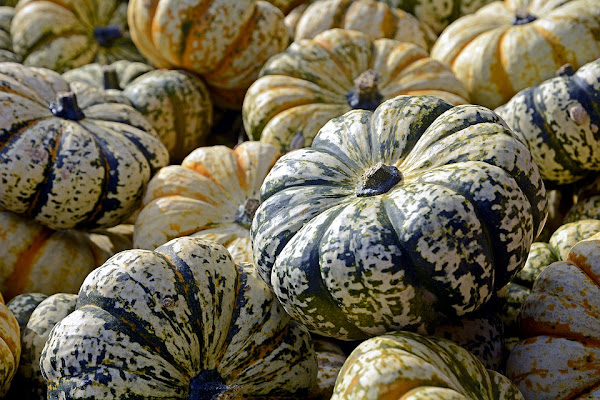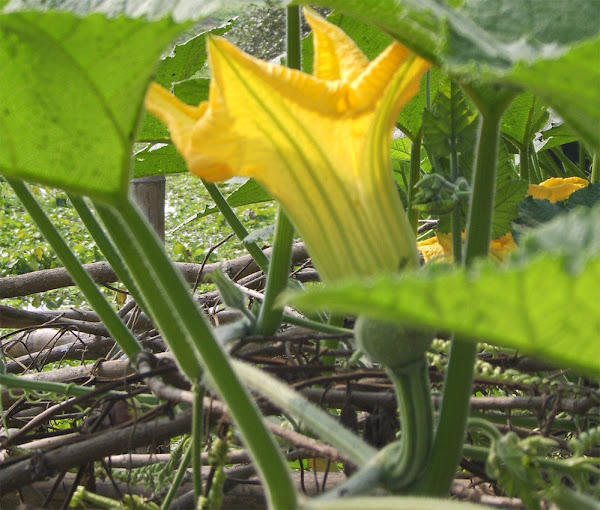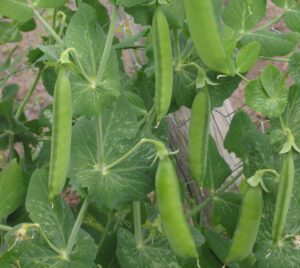Pumpkin farming is a very old, common and popular business throughout the world (except Antarctica continent). Actually pumpkin is a very popular vegetable crop in many countries around the world.
A pumpkin is a cultivar of winter squash that is round with smooth, slightly ribbed skin and is most often deep yellow to orange in coloration. The name ‘pumpkin‘ is most commonly used for cultivars of Cucurbita pepo, but some cultivars of Cucurbita maxima, C. argyrosperma, and C. moschata with similar appearance are also sometimes called “pumpkin”.[1]
Commercial pumpkin farming is very popular throughout the world where it grow. They are grown all around the world for a variety of reasons ranging from agricultural purposes (such as animal feed) to commercial and ornamental sales.
Pumpkin is native to North America, probably originated in northeastern Mexico and southern United States. And pumpkin plants are one of the oldest domesticated plants, having been used as early as 7500 to 5000 BC.
Commercial pumpkin farming is done for using as food, aesthetic and also for recreational purposes. Pumpkin pie, for instance, is a traditional part of Thanksgiving meals in Canada and the United States.
World production of pumpkins (including squash and gourds) was 27.6 million tonnes in 2018, with China and India accounting for half of the total. Russia and Ukraine each produced about one million tonnes.
Pumpkin farming is very popular in the United States, and it is one of the most popular crops in the USA. Over 680 million kilograms of pumpkins were produced in the United States in 2017.The top pumpkin-producing states include Illinois, Indiana, Ohio, Pennsylvania, and California.
However, here we are trying to describe more information about pumpkin nutrition, health benefits and commercial pumpkin farming system.
Nutritional Value Of Pumpkins
Pumpkins are very nutritious. They are high in vitamins and minerals while being low in calories, and are a great source of beta-carotene (a carotenoid that your body converts into vitamin A).
Pumpkin is about 1% protein, 0.1% fat, 6.5% carbohydrate and 92% water. According to healthline, one cup of cooked pumpkin (245 grams) contains:
- Protein: 2 grams
- Carbs: 12 grams
- Calories: 49
- Fat: 0.2 grams
- Fiber: 3 grams
- Iron: 8% of the RDI
- Copper: 11% of the RDI
- Manganese: 11% of the RDI
- Potassium: 16% of the RDI
- Vitamin A: 245% of the RDI
- Vitamin C: 19% of the RDI
- Vitamin B2: 11% of the RDI
- Vitamin E: 10% of the RDI
As you can see, pumpkin is packed with vitamins and minerals but relatively low in calories. It is also a very good source of beta-carotene. And the pumpkin seeds are also edible, which are very nutritious and linked to numerous health benefits.

Health Benefits of Consuming Pumpkins
Consuming pumpkins has many health benefits. It is a very good and safe food for almost all types of people. Here we are trying to describe the top health benefits of consuming pumpkins.
- Pumpkins are very low in calories, but they are high in minerals and vitamins. Especially, it is a great source of potassium and vitamin A.
- Pumpkins are high in antioxidant content and regular consumption may reduce your risk of chronic diseases. Pumpkins contain the antioxidants alpha-carotene, beta-carotene-beta cryptoxanthin and many others.
- Pumpkins are high in vitamins A and C, and both of these vitamins will help to boost your immune system. It’s supply vitamin E, iron and folate may strengthen your immunity as well.
- Consuming pumpkin is considered good for your eyes. It’s high vitamin A, lutein and zeaxanthin contents may protect your eyes against sight loss, which becomes more common with age.
- As pumpkins are low in calories, so consuming in moderation can help you to loose weight. They are also a good source of fiber, which may suppress your appetite.
- Pumpkins can lower the risks of stomach, throat, pancreas and breast cancers. Because they contain carotenoids, which function as antioxidants.
- High fiber in pumpkin, vitamin C, potassium and antioxidants can ensure good heart health.
- Pumpkins are high in beta-carotene, and beta-carotene acts as a natural sunblock.
- Vitamin C and E, as well as lutein and zeaxanthin all these can help your skin strong and healthy.
- Pumpkin is very healthy and considered safe for most of the people. So, you can consume pumpkin if you don’t experience allergies after eating pumpkin.
- You can enjoy pumpkins in many different ways. The seeds are also edible and highly nutritious.

What Are The Advantages/Benefits of Pumpkin Farming Business?
Commercial pumpkin farming is a very old and popular business. And commercial production of pumpkin is very popular in many countries around the world.
Pumpkin farming is very easy and simple, even the beginners can also start commercial pumpkin production. Commercial production is very profitable. However, here we are trying to describe the top advantages/benefits of commercial pumpkin farming business.
- Large scale or commercial pumpkin farming is a very old, common and popular business in many countries.
- Many people are already doing this business for earning their livelihood. People are growing pumpkins from the ancient time.
- You don’t have to worry much about starting this business. Because it is already an established business.
- Growing pumpkin is very easy and even the beginners can also start commercial production.
- Commercial production of pumpkin is very profitable. You can make pretty good profit from this business within a short period of time.
- Demand and value of pumpkin in the market are good.
- Pumpkins are very popular in the market. So, you don’t have to worry much about marketing your products.
- Pumpkin plants grow very well and caring them is relatively easy.
- Commercial pumpkin farming business can be a good employment source for the rural people. Especially for the unemployed educated people.
- Commercial production doesn’t require high investment. And you will get your invested money back within a very short period of time.
- Pumpkins are very nutritious. And there are many health benefits of consuming pumpkins regularly.
- You can enjoy fresh pumpkins if you start growing your own. You can also distribute some pumpkins to your relatives and friends 🙂
How to Start Pumpkin Farming Business?
Starting commercial pumpkin farming business is relatively easy and simple. Pumpkin plants generally grow well and it’s very easy and simple to care for the plants.

If you are a beginner, you should learn practically from existing farmers. However, here we are trying to describe more about starting commercial pumpkin farming business from planting, caring to harvesting and marketing.
Step 1: Site Selection
Pumpkin plants thrive well in a wide variety of soils, but sandy loam soil with good organic matter is best suited. Good drainage system is a must with the availability of full sun.
Availability of adequate organic matter and pH range between 6 and 7 are good for good growth of the plants.
Step 2: Land Preparation
Well prepared land is required for commercial pumpkin farming. Several ploughing with tractor is required to bring the soil to fine tilth. Add organic compost or FYM (farm yard manure) during final ploughing.
Step 3: Climate Requirement for Pumpkin Production
Pumpkins generally grow very well in the warmer months, as the seeds don’t germinate in cold weather. If you want to grow pumpkins in the northern areas, don’t plant the seeds until all danger of frost has passed and the soil has throughly warmed.
For commercial production, the seeds are generally planted in the warmer months (if you live in the southern areas). Generally May to July is the ideal time for growing pumpkins.
Step 4: Choose the Right Variety
It’s very important to choose the right variety. Your production will not be profitable if you can’t choose the right variety. So, choose the variety wisely. Consult with your local farmers for better recommendation.

Step 5: Purchase Seeds
Purchase good quality seed from any of your nearest seed supply stores after choosing the right variety for your business. Today, there are some companies available with online presence. So, you can also consider ordering the seeds online.
Step 6: Planting
Seed treatment is necessary before planting. Treatment with Benlate or Bavisting at the rate of 2.5 grams per kg of seed. Direct sowing method is used for planting pumpkin seeds.
The seeds are generally sown 1 inch deep in the soil. Sow two seeds on per hill and use spacing of 60cm. For hybrid varieties, sow seeds on both side of bed and use spacing of 45cm.
Step 7: Caring
Additional caring is required for better growth of the plants and also for better pumpkin production. So, try to take good care of your plants.
Feeding/Fertilizing
Providing additional fertilization is necessary for commercial pumpkin production. Application of well rotten FYM at the rate of 8-10tonnes per acre is used before preparation of beds.
Fertilizer dose of Nitrogen at the rate of 40kg per acre in the form of urea at the rate of 90kg per acre, Phosphorus at the rate of 20kg per acre in the form of SSP at the rate of 125kg per acre and Potassium at the rate of 20kg per acre in the form of MOP at the rate of 35kg per acre is added.
Nitrogen dose is applied in 2 equal splits. First half dose is applied before sowing and then remaining dose of nitrogen is applied as top dressing within one month.
Watering
Adequate irrigation at right interval of time is essential. Water the field immediately after sowing seeds. And subsequent irrigation are needed depending upon the season (at the interval of 6 to 7 days). A total of 8-10 irrigation are required.
Mulching
Mulching is a good option for retaining moisture into the soil. And it also helps to control weeds. You can use organic materials for mulching.

Weeding
Weeds consume nutrients from the soil. So, it’s important to control the weeds. Frequent weeding or earthing up operation will help to control weeds. First weeding is done after 2-3 weeks of seed sowing. In total 3-4 weeding are required to make the field weed free.
Step 8: Control Pests & Diseases
Pumpkin plans are susceptible to some pests and diseases. Common pests and diseases and their controlling methods are mentioned below.
Pests and Their Control
Pumpkin Flies
Pumpkin flies cause sunken brown color spot on fruits and white maggot gets develop on the fruit. Foliar application of Neem oil at the rate of 3% is given to cure the crop from fruit fly pest.
Aphids and Thrips
Both aphids and thrips suck the sap from the leaves resulting in yellowing and drooping of leaves. For controlling these pests, spray the crop with Thiamethoxam at the rate of 5 gram per liter of water.
Diseases and their Control
Anthracnose
Affected plants in anthracnose disease appears scorched appearance. Take spray of Mancozed at the rate of 2 grams per liter of water if observe infestation. Treat the seed with Carbendazim at the rate of 2 grams per kg of seed as a preventive measure.
Downy Mildew
This disease is caused by Pseudopernospora cubensis. Mottling and purplish color shots on the lower surface of the leaves are the common symptoms. If infestation is observed, 400gm Dithane M-45 or Dithane Z-78 is used to get rid of this disease.
Powdery Mildew
Patchy, white powdery growth appears on upper surface of leaves also on main stem of infected plant. If infestation is observed take spray of water soluble Sulphur at the rate of 20gm per 10Ltr of water 2-3 times with interval of 10 days.
Wilt
Root rotting is a result of this disease. Drenching with M-45 at the rate of 400 grams mixed with 100 litter of water is done if infestation is observed.
Step 9: Harvesting
Harvesting of pumpkin is generally done when skin of he fruits turn pale brown in color and inner flesh becomes golden yellow in color.
Mature pumpkins have good storage capacity, and they can be used for long distance transportation. Sometimes, harvesting of immature fruits is also done for sale purpose.
Step 10: Yield
It’s very difficult to tell an exact amount. Pumpkin yield mainly depends on plant management and the variety of crop. An average yield of pumpkin can be expected up to 30 tonnes per hectare.
Step 11: Marketing
Marketing pumpkins is very easy and simple. After harvesting, they can be transported to local markets. You can also try selling your products to your nearest town. However, determine your marketing strategies first before starting this business.

These are the common steps and ways for starting and operating a commercial pumpkin farming business. Hope this guide has helped you! Good luck!
Frequently Asked Questions (FAQs)
People ask many questions about pumpkin farming. Here we are trying to list the most common questions about pumpkin farming, and trying to answer them. Hope you will find your answer. Don’t hesitate to ask us if you have more questions.
Is pumpkin farming profitable?
Yes, pumpkin farming is a very profitable business. You can make good profits from this business.
How to start pumpkin farming business?
Starting a profitable pumpkin farming business is very easy and simple. You can easily start this business for making money. First of all, select a very good location, select good variety, prepare the soil, plant the seeds, water the plants and your plants will producing pumpkins after a few weeks.
How profitable is pumpkin farming?
Pumpkin farming is very profitable. You can make very good profits from this business. Although, it’s not possible to tell the exact amount. Please consult with an existing farmers in your area for having some ideas.
How long does it take to fully grow a pumpkin?
It generally take between 90 and 120 days to mature after the seeds are planted. Although, exact time depends on the pumpkin variety.
Are pumpkins easy to farm?
Yes, growing pumpkins is very easy to grow. You can start growing pumpkins even if you are a beginner.
Where do pumpkins grow best?
Pumpkins generally grow and thrive well in well-drained and fertile soil which is located in a warm, and sunny spot.
Is pumpkin a cash crop?
Yes, it is an ideal cash crop for American farmers.
What do farmers do with unsold pumpkins?
Most of the farmers used to store the unsold pumpkins in their farm, and they generally donate to other local farmers.
How many pumpkin can you get from one plant?
It actually depends on the variety you are growing. The number of pumpkin per plant can vary from 2-5 pumpkins.
How many pumpkins will one acre produce?
You can expect an average yield of about 1000 pumpkins per acre.
Do pumpkins need a lot of water?
Yes, pumpkin plants need a lot of water. Actually pumpkins are 80 to 90 percent water.
What makes pumpkins grow faster?
The pumpkins plants generally grow faster by using nitrogen-rich fertilizers. Providing organic fertilizers will also produce better result.
How long is the life cycle of a pumpkin?
Average lifespan of a pumpkin plant is between 120 and 150 depending on the variety you are growing.
Do pumpkins need full sun?
Yes, the pumpkin plants generally need full sun for better growth.
What climate do pumpkins grow in?
Pumpkins generally grow well in warm weather with full sun. The plants do best in temperature between 65°F and 95°F.
How long will pumpkins keep after harvesting?
You can keep the pumpkins for up to 3 months after harvesting.






I want to learn more about this